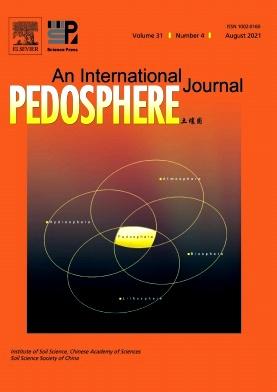全球变化因素导致温带草原土壤养分动态脱钩、微生物群落与生态功能不同步
IF 7.3
2区 农林科学
Q1 SOIL SCIENCE
引用次数: 0
摘要
土壤微生物群落和草地生态系统过程日益受到多重全球变化因子的影响。目前还缺乏对这多种gcf如何相互作用和影响土壤微生物群落及其功能的研究。为了解决这一差距,我们进行了一个模拟实验,研究了四个最关键和最普遍的gcf,即二氧化碳浓度升高(eCO2)、温度升高(eT)、降水减少(dP)和氮沉降(eN)升高的个体和相互作用。本文研究了它们对温带草原土壤理化性质、细菌和真菌群落以及与碳(C)、氮(N)和磷(P)循环相关的细胞外酶活性(EEAs)的影响。结果表明,eCO2、eN和dP均有增加EEAs的趋势,而对微生物多样性和群落组成的影响为中性。另一方面,eT降低了土壤pH、全碳、全氮、EEAs和微生物多样性,但增加了植物生物量、全磷、微生物丰富度、网络复杂性和稳定性。在变暖条件下,养分限制从磷向氮的转变导致了养分的脱钩。酶活性与微生物丰富度、多样性和优势种呈中性或略负相关,微生物群落与生态功能的响应呈非同步关系。重要的是,我们的研究结果揭示了gcf之间显著的高阶相互作用,并发现它们对土壤理化性质、微生物群落和生态功能有显著影响。这些发现为生态适应未来全球变化提供了有价值的见解和建议。本文章由计算机程序翻译,如有差异,请以英文原文为准。
Global change factors cause decoupling of nutrient dynamics and asynchrony between microbial communities and ecological functions in a temperate grassland soil
Soil microbial communities and grassland ecosystem processes are increasingly confronted with multiple global change factors (GCFs). There is still a lack of research on how these multiple GCFs interact and impact soil microbial communities and their functions. To address this gap, we conducted a simulation experiment to examine the individual and interactive effects of the four most critical and prevalent GCFs, elevated carbon dioxide concentration (eCO2), elevated temperature (eT), decreased precipitation (dP), and elevated nitrogen (N) deposition (eN). This study focused on their effects on soil physicochemical properties, bacterial and fungal communities, and extracellular enzyme activities (EEAs) related to carbon (C), N, and phosphorus (P) cycles in a temperate grassland. Results showed that eCO2, eN, and dP tended to increase EEAs, while having neutral effects on microbial diversity and community composition. On the other hand, eT resulted in decreases in soil pH, total C, total N, EEAs, and microbial diversity, but increases in plant biomass, total P, microbial richness, and network complexity and stability. This shift in the nutrient limitation from P to N under warming conditions resulted in decoupling of nutrients. Neutral or slightly negative relationships were found between enzyme activities and microbial richness, diversity, and dominant species, and the responses of microbial communities and ecological functions were asynchronous under GCFs. Importantly, our results revealed significant higher-order interactions among GCFs and found that they had notable effects on soil physicochemical properties as well as on microbial communities and ecological functions. These findings provide valuable insights and suggestions for ecological adaptations to future global changes.
求助全文
通过发布文献求助,成功后即可免费获取论文全文。
去求助
来源期刊

Pedosphere
环境科学-土壤科学
CiteScore
11.70
自引率
1.80%
发文量
147
审稿时长
5.0 months
期刊介绍:
PEDOSPHERE—a peer-reviewed international journal published bimonthly in English—welcomes submissions from scientists around the world under a broad scope of topics relevant to timely, high quality original research findings, especially up-to-date achievements and advances in the entire field of soil science studies dealing with environmental science, ecology, agriculture, bioscience, geoscience, forestry, etc. It publishes mainly original research articles as well as some reviews, mini reviews, short communications and special issues.
 求助内容:
求助内容: 应助结果提醒方式:
应助结果提醒方式:


